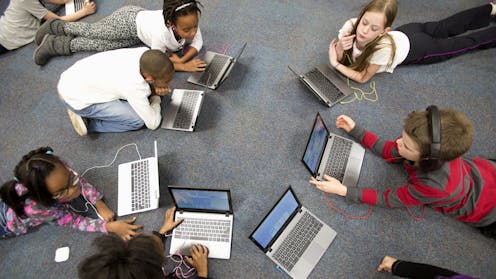AI is taking hold in K-12 schools – here are some ways it can improve teaching
Leading thinkers in the field are seeking a more nuanced understanding of how best to use AI to shape the future of education.

Generative AI platforms have sent shock waves through the K-12 education sector since the public release of ChatGPT nearly three years ago.
The technology is taking hold under the belief that students and teachers need to be proficient in these powerful tools, even though many concerns remain around equity, privacy, bias and degradation of critical thinking among students.
As a professor who teaches future educators and is part of an AI-focused working group, I have observed the potential for artificial intelligence to transform teaching and learning practices in K-12 schools. The trends I am seeing – and that I encourage – are for K-12 educators to use AI to shift from memorization and rote learning to instead emphasize critical thinking and creativity.
Jumping in the deep end
After the public release of ChatGPT in late 2022, some large school districts initially banned the use of AI due to concerns about cheating. Surveys also reflected worries about chatbots fabricating information, such as references for school papers, in addition to concerns about misinformation and biases existing in AI responses to prompts.
Students, on the other hand, tended to jump into the deep end of the AI pool. Common Sense Media, which offers recommendations on children’s media consumption, published a report in 2024 showing that students were using AI-supported search and chatbots for homework and to stave off boredom as well as other personal reasons, including “creating content as a joke, planning activities, and seeking health advice.” Most of the teachers and parents of the students in the study were unaware that students were using the technology.
In my work at Drexel University teaching graduate students who are aspiring school principals or superintendents, I found that in 2023, K-12 students were afraid of using AI due to the policies implemented in their districts banning it. However, it quickly became apparent that students were able to mask their use of AI by instructing AI to insert some mistakes to their assignments.
Meanwhile, despite teachers’ initial concerns about AI, approximately 60% of K-12 teachers now admit to using AI to plan lessons, communicate with parents and assist with grading. Concerns over students cheating still exist, but time-strapped teachers are finding that using AI can save them time while improving their teaching.
A recent Walton Foundation and Gallup study revealed that teachers who used AI tools weekly saved an average of 5.9 hours per week, which they reallocated to “providing students more nuanced feedback, creating individualized lessons, writing emails and getting home to their families in a more reasonable time.”
Opening up new ways of teaching
I recommend that my graduate students use AI because I think ignoring emerging trends in education is not wise. I believe the benefits outweigh the negatives if students are taught ethical use of the technology and guardrails are put in place, such as requiring that AI be cited as a source if students use it in coursework.
Advocates say AI is changing teaching for the better, since it forces teachers to identify additional ways for students to demonstrate their understanding of content. Some strategies for students who rely too heavily on AI include oral presentations, project-based learning and building portfolios of a student’s best work.
One practice could involve students showing evidence of something they created, implemented or developed to address a challenge. Evidence could include constructing a small bridge to demonstrate how forces act on structures, pictures or a video of students using a water sampling device to check for pollution, or students designing and planting a community garden. AI might produce the steps needed to construct the project, but students would actually have to do the work.
Teachers can also use AI to create lessons tailored to students’ interests, quickly translate text to multiple languages, and recognize speech for students with hearing difficulties. AI can be used as a tutor to individualize instruction, provide immediate feedback and identify gaps in students’ learning.
When I was a school superintendent, I always asked applicants for teaching positions how they connected their classroom lessons to the real world. Most of them struggled to come up with concrete examples. On the other hand, I have found AI is helpful in this regard, providing answers to students’ perennial question of why they need to learn what is being taught.
Thought partner
Teachers in K-12 schools are using AI to help students develop their empathetic skills. One example is prompting an AI to “redesign the first-day experience for a relocated student entering a new middle school.” AI created the action steps and the essential questions necessary for refining students’ initial solutions.
In my own classroom, I’ve used AI to boost my graduate students’ critical thinking skills. I had my students imagine that they were college presidents facing the loss of essential federal funding unless they implemented policies limiting public criticism of federal agencies on campus. This proposed restriction, framed as a requirement to maintain “institutional neutrality,” requires students to develop a plan of action based on their knowledge of systems and design thinking. After each team developed their solution, I used AI to create questions and counterpoints to their proposed solution. In this way, AI becomes a critical thought partner to probe intended and unintended outcomes, gaps in students’ thinking and potential solutions that might have been overlooked.
AI researcher Ethan Mollick encourages educators to use AI as a springboard, similar to jazz musicians improvising, as a way to unleash new possibilities. Mollick advises people to partner with AI as co-intelligence, be the human in the loop, treat AI as a co-worker, albeit one that needs to be prodded for evidence, and to learn to use it well. I concur.
Changing perspectives on AI
Some early studies on the effects of using AI in education have raised concerns that the convenience of generative AI will degrade students’ learning and erode their critical thinking skills.
I think that further studies are needed, but I have found in my own work and in the work of my graduate students that AI can enhance human-produced work. For example, AI-powered teaching assistants, like Khanmigo or Beghetto Bots, use AI to help students solve problems and come up with innovative solutions without giving away the answers.
My experiences with other educators on the front lines show me that they are beginning to change their perspectives toward students using AI, particularly as teachers realize the benefit of AI in their own work. For example, one of my graduate students said his district is employing a committee of educators, students and outside experts to explore how AI can be used ethically and in a way that won’t erode students’ critical thinking skills.
Educators are starting to realize that AI isn’t going away anytime soon – and that it’s better to teach their students how to use it, rather than leave them to their own devices.
Michael G. Kozak does not work for, consult, own shares in or receive funding from any company or organization that would benefit from this article, and has disclosed no relevant affiliations beyond their academic appointment.
Read These Next
The battle over a global energy transition is on between petro-states and electro-states – here’s wh
While wind and solar energy led in investments globally, liquefied natural gas is also booming. A former…
With less charitable giving flowing directly to charities, a tax policy scholar suggests some policy
Even when donors have good intentions, philanthropy does not always produce good results.
Virtual National Science Foundation internships aren’t just a pandemic stopgap – they can open up op
Students who participated in the virtual Research Experience for Undergraduates at Purdue reported stronger…





